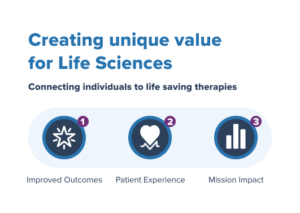
Three Ways Life Sciences Organizations Can Use SDoH Insights to Inform Whole-Person Care
Since the pandemic, healthcare organizations are increasingly aware of the powerful role social determinants of health (SDoH) play in whole-person care. Life sciences organizations, in particular, are seeking ways to incorporate SDoH insights across their business processes, from discovery and development to initiatives that promote adherence, patient education, population health, and community impact.
SDoH are non-clinical contributors to whole-person health. Such behavioral, personal, lifestyle, socio-economic, and environmental factors are responsible for around 80 percent of an individual’s overall health status. In contrast, clinical care influences only around 15 percent of health status, but absorbs 60 percent of U.S. healthcare spending. Redressing that imbalance with programs and services that incorporate SDoH insights into their strategy is increasingly critical, particularly for underrepresented populations and in value-based markets.
Yet it’s often a challenge for life sciences organizations to identify SDoH needs for the communities they serve and apply data-driven insights effectively.
Here are three areas where data-driven SDoH insights can have a transformational impact on whole-person care, adherence, health equity, and patient engagement while also optimizing business processes and organizational outreach.
1. Use Data-Driven SDoH Insights to Enhance Every Aspect of the Product Life Cycle
As medication and therapies become more targeted and measuring outcomes becomes increasingly important, life sciences organizations can incorporate SDoH into every aspect of the product life cycle, starting with discovery and development.
Data-driven SDoH insights can enhance understanding of the health conditions, circumstances, and challenges of specific patient populations at higher risk of disease. For example, mortality rates for Black women with breast cancer are 41 percent higher than for white women. When we start to take a deeper look at the underlying factors behind these statistics, we can see that there are many non-clinical factors, such as lack of transportation or access to child care, that can impede treatment or diagnosis. SDoH insights help identify these critical, human-centered components and inform the product life cycle, starting with discovery and development.
Clinical trials have historically struggled to engage individuals from underrepresented communities. The failure to include representative members in clinical trials has influenced discovery and development and impeded effectiveness for those communities. According to the Lancet, between 2000 and 2020, the majority of clinical trials in the United States did not report specific race/ethnicity enrollment data, but white people likely represented 80 percent of enrollees.
SDoH needs—such as access to transportation and childcare—significantly impact the extent to which individuals are able to participate in clinical trials. Data-driven understanding of those barriers can help life sciences organizations and contract research organizations (CROs) source a more representative population of patients, facilitate their participation and long-term engagement, and address community distrust in the discovery and development processes.
Connecting with communities at the ground level can better inform collective understanding of the barriers and challenges faced by certain patient populations. Clinical trial engagement can be greatly enhanced through the support of trusted community partners who have real relationships with potential trial participants.
In a clinical trial conducted by Vanderbilt Academic Medical Center in 2011, community experts addressed the specific social barriers for trial participants, including transportation, appointment flexibility, and tailored marketing materials. These insights helped researchers increase enrollment by 78 percent and meet recruitment goals 16 months ahead of schedule while achieving 100 percent participant retention and study adherence.
SDoH insights can also help identify barriers to care within patient populations and communities. Such insights enable life sciences organizations to develop localized patient strategies across key markets and engage relevant health providers and community resources for therapy-specific programs.
2. Recognize the Role SDoH Play in Adherence and Health Outcomes
Medication and therapy efficacy alone is not enough to ensure better health outcomes. Medication non-adherence remains one of the biggest drivers of poor health outcomes and increased healthcare costs.
Non-adherence is particularly common among patients suffering from chronic disease, such as diabetes, hypertension, and cardiovascular conditions. Often, the same non-clinical factors that can impede initial treatment or diagnosis may also play a role in non-adherence. Non-adherence to medication for chronic illnesses increases healthcare system costs by over $600 billion each year. The ability to identify relevant patient populations within these chronic disease states and develop data-driven programs that connect patients to resources in the community represents a tremendous opportunity to enable the patient journey, increase adherence, and improve overall outcomes.
A complex range of factors typically influences noncompliance, including socioeconomic circumstances and access to care. A study by Unite Us showed that populations with elevated social risk, as defined through Unite Us Social Needs System taxonomy for measuring SDoH, have seven percent lower care compliance across key measures, including:
- Breast cancer screening
- Colorectal cancer screening
- Medication adherence: statins (PDE)
- Medication adherence: diabetes (PDE)
- Medication adherence: RAS (PDE)
- Osteoporosis management in women who had a fracture
- Annual wellness visit
- Diabetes care: HbA1c test
- Primary care visit
Single-factor interventions rarely move the needle for patients facing chronic illness. SDoH insights can significantly inform interventions that improve adherence by identifying the non-medical reasons that impact non-adherence. Factors like lack of transportation, secure housing, adequate food, access to pharmacies, or poor health literacy can intersect in complex ways.
Knowing which factors to address, how to track utilization, and how to measure the impact of therapies and interventions long-term are all key to improving whole-person care, patient engagement/experience, health outcomes, and health equity.
With robust, data-driven insights, life sciences organizations can also predict and measure the impact of specific social care interventions—like providing transportation or food—in collaboration with community partners. This enables organizations in at-risk arrangements to improve outcomes in cost-effective ways and design intervention opportunities to improve results.
3. Enhance the Impact of Investments in Patient Care and Communities
Life sciences organizations can also contribute toward providing culturally competent resources to help mitigate needs that drive noncompliance in the first place.
 Connecting with a strong network of community-based, social care organizations can go a long way in supporting historically underrepresented communities. To improve adherence and outcomes across many populations at scale, life sciences organizations not only need access to such an infrastructure, but they also need data-driven SDoH insights to direct, track, and measure the impact of their efforts to ensure dollars are spent effectively and efficiently.
Connecting with a strong network of community-based, social care organizations can go a long way in supporting historically underrepresented communities. To improve adherence and outcomes across many populations at scale, life sciences organizations not only need access to such an infrastructure, but they also need data-driven SDoH insights to direct, track, and measure the impact of their efforts to ensure dollars are spent effectively and efficiently.
Patient and provider education is another important component. With better understanding of patient populations, life sciences organizations can target messaging appropriately, identify the right channels for those messages, and improve patient engagement and marketing ROI exponentially. This can not only improve adherence but screening and preventative care as well.
Life sciences is already among the most philanthropic sectors in the world. With the right data-driven SDoH insights, life sciences can invest in communities and patients more effectively while improving trust in their organizations and in the efficacy of their therapies.
Advancing Whole-Person Care, Health Equity, and Organizational Performance
Every healthcare organization is more aware today of how disparities in health equity and SDoH influence health outcomes, whole-person health, and overall healthcare costs.
Life sciences organizations can take a leading role in addressing these disparities and improving whole-person health by incorporating SDoH insights into their business processes and by coordinating services with providers, payers, community partners, advocacy and support organizations, government agencies, and patients. Specifically, they can leverage data-driven insights to support strategic initiatives that advance adherence and improve outcomes.
By addressing the social determinants of health, life sciences organizations can help build the future infrastructure of care and meet the challenge of health equity through targeted and effective investments.
Visit Unite Us to learn more about transforming patient services with whole-person care.
About Unite Us
Unite Us is the nation’s leading software company bringing sectors together to improve the health and well-being of communities. We drive the collaboration to predict, deliver, and pay for services that impact whole-person health. Through Unite Us’ national network and software, community-based organizations, government agencies, and healthcare organizations are all connected to better collaborate to meet the needs of the individuals in their communities.



